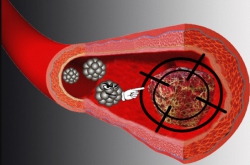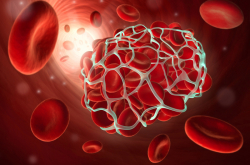Currently, thrombosis-related conditions remain the leading cause of death. There are only two conventional ways of treatment out there: either surgery that requires a complex, high-risk operation, or thrombolytics. Although this class of drugs emerged as a treatment method about 40 years ago, so far it has failed to become widespread because of the side effects that occur during its systemic use. To avoid these effects, the action of a trombolytic should be localized, meaning that the drug must be delivered right to the clot. To do this, scientists use magnetic nanoparticles.
Researchers at ITMO University are developing thrombolytic drugs based on magnetite nanoparticles coated with heparin and urokinase. Magnetite is a biocompatible iron oxide with pronounced magnetic properties. Therefore, magnetite particles movement can be controlled with a magnetic field. Urokinase is a first-generation thrombolytic with simple molecules, affordable price and efficiency almost equal to newer drugs. As soon as the nanoparticles with urokinase are injected into the blood, they can be sent to the place of clot formation using a magnetic field. Once the clot is destroyed, the magnetic field is turned off, the nanoparticles are redistributed to the liver and spleen and, finally, gradually removed.

“We chose to focus on simple and inexpensive substances to make the final product affordable. Since urokinase and magnetite are equally charged, we had to use a linker. We opted for heparin, an anticoagulant that often comes with thrombolytics in order to thin the blood. Typically, heparin inhibits urokinase, but we managed to avoid this effect. Preclinical trials showed that we also managed to achieve high efficiency and minimize side effects,” comments Arthur Prilepskii, member of the SCAMT Laboratory of ITMO University.
The new drug successfully passed preclinical studies that included toxicity, allergenicity, mutagenicity, and immunotoxic tests. No side effects were identified during animal trials. At the same time, the range of permissible drug concentrations turned out to be very high, while the minimum dose of urokinase necessary to achieve a therapeutic effect was approximately two orders of magnitude lower than with the introduction of usual urokinase. What’s more, the clot dissolution rate of the new drug proved to be 20 times shorter than that of its conventional counterparts.

“Preclinical trials were conducted as part of the Pharma 2020 project. The project consisted of three stages spanning two years, during which the synthesis of the drug was optimized. We have also carefully studied chemical characteristics efficacy and safety of the new medication,” notes Anna Fakhardo, researcher at the SCAMT Laboratory of ITMO University.
Reference: Urokinase-Conjugated Magnetite Nanoparticles as a Promising Drug Delivery System for Targeted Thrombolysis: Synthesis and Preclinical Evaluation. Artur Prilepskii et al. ACS Appl. Mater. Interfaces



